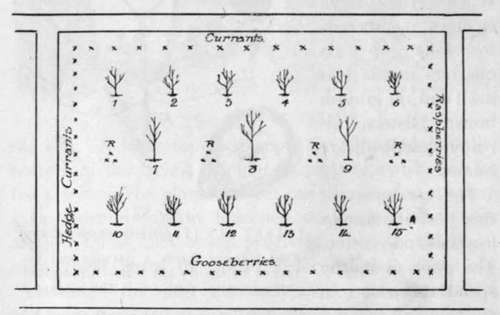Chapter XIII. Fruit Culture. The Fruit Plot
Description
This section is from the book "School Gardening", by W. Francis Rankine. Also available from Amazon: School Gardening.
Chapter XIII. Fruit Culture. The Fruit Plot
Wherever possible, a fruit plot should be established in the school garden, in fact, no system of school garden teaching can be considered complete if no provision is made for elementary training in fruit culture. The provision of space is the only serious difficulty ; the question of expense may be passed over, for it should be remembered that the stock of healthy and carefully selected fruits planted will not require replacing year by year as in the case of the vegetable crops. The expense may be reckoned as an outlay of ten shillings to fifteen shillings per rod, and if the trees are correctly managed from the first there is no call for further expense for some years. An occasional inevitable death may cause incidental expense. The question of space may be overcome, since it is not essential that large areas shall be utilised. A few trees on a small plot will furnish all that is required for one class of fourteen boys. Thus even two rods of ground may be transformed into a very useful although small fruit plot. A much more convenient plot can be acquired by using four rods of ground, and the accompanying diagram, Fig. 54, represents such a plot in actual use in a Surrey school garden. The planting plan, as shown, was specially prepared by Mr. John Wright, V.M.H., and is an object lesson in the economy of using space. It will be noted that by an ingenious arrangement of grouping and spacing the representative fruits are planted so that each commands sufficient room for development. The taller fruits are given central positions in order that sunshine and light have full access to the whole, without interfering with the bush varieties. The bush or berry fruits form the boundaries. The great danger rests in the fact that many growers endeavour to accommodate more trees than can develop under satisfactory conditions. Promiscuous planting and overcrowding are inimical to success and leads to failure as well as waste of time and money. Therefore, when the available space is limited, the number of trees introduced must be correspondingly restricted as tending to ensure success and thus accomplish the object and aim of school gardening. If. however, the plot at disposal is unlimited, a larger number and a wider variety of trees may be planted, yet, always with due attention to the question of root space and leaf room. There is no economy in overcrowding ; on the contrary, it is extravagant waste.

Fig. 54. A School Garden Fruit Plot.
1,2,3,5,6,10,12,13,15. Bush apples. 8. Half standard apple. 4. A Bush plum. 7, 9. Half standard plums. 11, 14. Pyramid pears.
R = Raspberries.
Another reason in favour of the formation of a fruit plot is the value of the winter occupation afforded when the vegetable garden operations are completed or suspended. On favourable days in winter the trees can be given the important attention they require, and much instructive and interesting work may be performed.
The selection of the situation of the fruit plot must be based on several considerations. A sunny position and a southerly aspect are desirable. The soil demands thorough cultivation, and this is best accomplished by bastard trenching. It must be borne in mind that the root development of the fruit trees is more important at the outset than the growth above ground, and that freedom of root growth cannot be obtained in a neglected soil. The question of drainage is of the greatest importance, and success in fruit growing, even on the most modest scale can never be realised in a badly drained soil. The presence of excessive moisture means a lowering of temperature, and provides -all the conditions that retard root extension. Although the roots are out of sight, yet it is fatal to the tree if they are out of mind. Therefore, everything that is possible in the direction of deep cultivation must be completed before planting is attempted. The bastard trenching must be carried out with the same thoroughness, but deeper than that • recommended in Chapter II, yet due attention must be given to the warning against bringing the rank, foodless subsoil to the surface. Be it also clearly apprehended that the establishing of young trees is the most important stage in the work entailed by the fruit plot. Carelessness in this work will result in endless worries in subsequent work ; it will call* for replanting and probably the discarding of those trees that have failed through the negligence of the grower. The manuring of the fruit plot must be judiciously carried out, and on no account must fresh, rank manure be placed in such positions that it will be in direct contact with roots of newly planted trees. Such treatment stimulates excessive root growth and causes the production of coarse and fruitless shoots.
Due attention must be given to the manner in which roots carry on the work of supporting the tree. This important function is shared by roots, rootlets, and root-hairs alike and consists in extracting plant food from the soil and passing it into the plant system. Thus the fibrous roots of the tree are of as much importance as the main roots, and require attention accordingly, and they cannot extend sufficiently in a badly cultivated soil.
Continue to:
